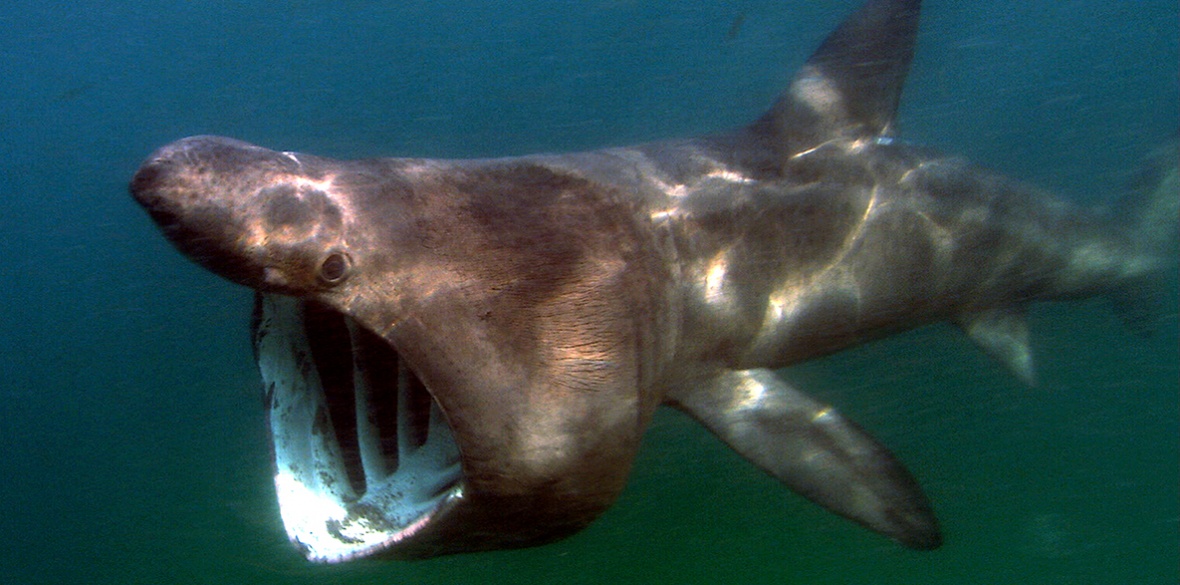This is the last article you can read this month
You can read more article this month
You can read more articles this month
Sorry your limit is up for this month
Reset on:
Please help support the Morning Star by subscribing here
A ROBOT camera has been used in British seas for the first time to monitor the behaviour of huge basking sharks (Cetorhinus maximus) off the Scottish coast.
Marine scientists have just spent a week off the coast of Mull in the Inner Hebrides tagging three basking sharks using the cameras attached to the shark’s dorsal fin and trailing behind the huge fish. This type of tag has never before been used to film basking sharks.
Basking sharks are the second-largest fish in the world, an endangered species weighing up to seven tonnes and 33 feet (10m) long with a huge mouth over three feet (1m) wide.
They got their name because they’re often seen feeding at the surface of the water, where they look like they’re basking in the sun.
Basking sharks live for at least 50 years. Males reach maturity at 12-16 years, females at 20 years.
They are no danger to humans, but sadly humans are very dangerous to them. They are now totally protected in British waters but were hunted here until 1981.
From 1946-95 basking sharks were heavily fished in the north-east Atlantic. They were targeted for their liver oil, meat and large fins.
Basking shark fisheries displayed a typical boom-and-bust pattern. Large volumes of mature basking sharks were initially caught followed by a rapid decline of landings until fisheries collapsed, no longer financially viable. Gradually stocks would recover and the hunting would start again.
The last commercial basking shark fishery in British waters closed in 1995, leaving populations on the brink of extinction. Now basking sharks are Red List endangered.
Monitoring, management and further research is vital to ensure their survival.
The liver makes up a third to half of the body weight. It was once used as lamp oil but now it is used mainly in cosmetics.
The fins, used in shark fin soup a well as dubious Chinese cures, are poached all over the world.
When you know that a single basking shark dorsal fin can sell for £40,000 it easy to understand why.
Despite their size and prevalence in Scotland’s seas, little was understood about their social behaviour and breeding habits. It is believed that despite many efforts, no scientist has ever witnessed basking sharks actually mating.
Sharks and other fish such as skates and rays actually have two “penises.” (No jokes, please, about happy dogfish — a type of shark).
The external appendages, very similar to a penis, are called claspers. They are designed to deliver sperm inside a female.
However, they are dissimilar to a penis in that they are not an independent appendage, but deeply grooved cartilaginous extensions of the shark’s pelvic fins.
Sharks attract eel-like parasitic lampreys which attached under the shark can be confused with a penis and can lead to sexual misidentification.
Despite their size, these sharks are capable of leaping clear out of the water, a behaviour better known in whales and dolphins and called breaching.
They breach often when in large groups and during courtship, so this may be sexual showing off or it could also help to dislodge those external parasitic lampreys.
A few fishermen and divers have reported seeing basking shark activity that may be mating. They report that the actual act is very violent.
Sharks have internal fertilisation, like mammals. The male must insert his genetic material into the female’s body using his claspers. How he does it without hands, limbs or paws nobody knows.
We know it involves a lot of biting, thrashing, rolling and, most important, pinpoint positioning.
The male clamps his toothless mouth on to the female’s fin. Females often have scarred fins thought to be caused by mating. He then wraps his body round hers until their sexual organs are perfectly aligned.
The female will keep the fertilised eggs in her uterus for between one and three years.
Up to half a dozen unborn shark pups may feed on her unfertilised eggs growing to a birth size of 4ft (1.5m).
The new robot camera named SharkCam filmed the sharks off the west coast of Scotland where they had been thought to gather to breed after migrating from waters off west Africa.
In fact, SharkCam found that much previous thinking about basking shark behaviour was quite wrong.
The pictures taken off the coasts of Coll and Tiree suggest the sharks arrive in Scottish waters to breed rather than feed as was thought previously.
In the Hebrides, off Skye and on the west Highland coast, tourists take specialist shark-watching boats to see sharks swimming close to the surface with their huge gaping mouths wide open to catch plankton.
The mouth has no teeth. Instead long comb-like structures trap zooplankton filtering up to 2,000 tonnes of water per hour.
Scientists studying the new footage noted the sharks spent long periods just above the seabed gathering in sociable groups and not feeding.
Dr Suzanne Henderson, of NatureScot, formerly Scottish Natural Heritage, told us: “While we weren’t lucky enough to capture courtship or mating behaviour on camera this time, this innovative study has shed more light on the lives of these spectacular giant fish.
“The fact that the sharks spent much more time swimming just above the seabed than we previously thought, and with their mouths closed, is really interesting, particularly as the species is often thought of as a pelagic or near-surface filter feeding shark.”
She added: “There’s very little information about social and mating behaviours in basking sharks, or indeed sharks in general.
“We’ve been unsure whether the surface behaviours we see in the Hebrides — such as parallel swimming, following nose to tail, or swimming in tight circles — are courtship activities.”
It is hoped that future footage will record basking sharks mating. This would be the first such recording.
Alongside the data collected by the new cameras, genetic profiles were created from DNA extracted from swabs of skin mucus taken from swimming sharks. These swabs have built a register of more than 400 unique DNA profiles.
Dr Catherine Jones, who helped to lead the study, said: “Perhaps relatives hang out together, which could facilitate learning migration routes and encourage other co-operative behaviours.
“This means there’s more going on in basking shark aggregations than first appears. They don’t fit the shark stereotype of a lonesome independent predator.”
Stuart McMillan, the Scottish Nationalist MSP for Greenock and Inverclyde, is a basking shark species champion.
He told us: “We need marine protected areas in Scottish seas to offer a chance to safeguard our precious marine life for future generations.”










